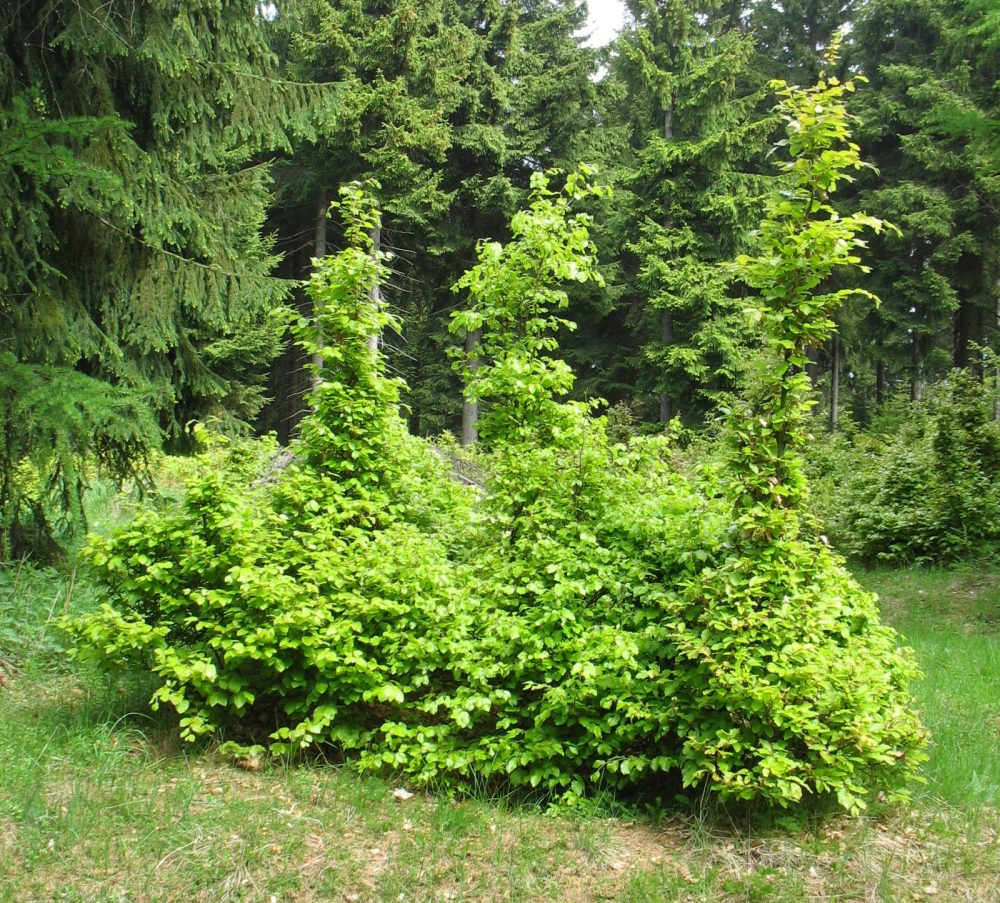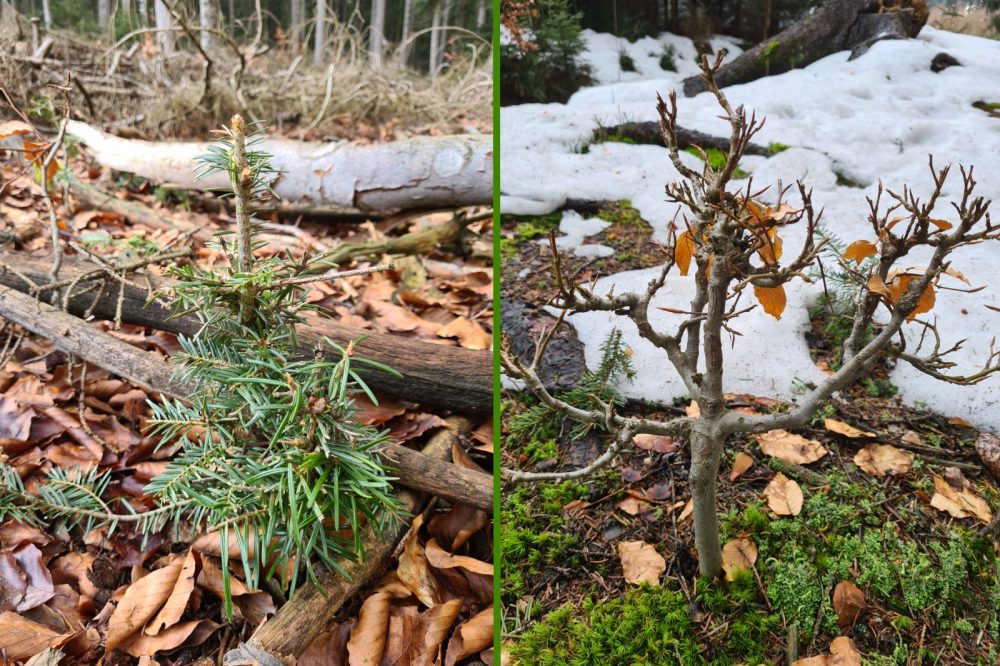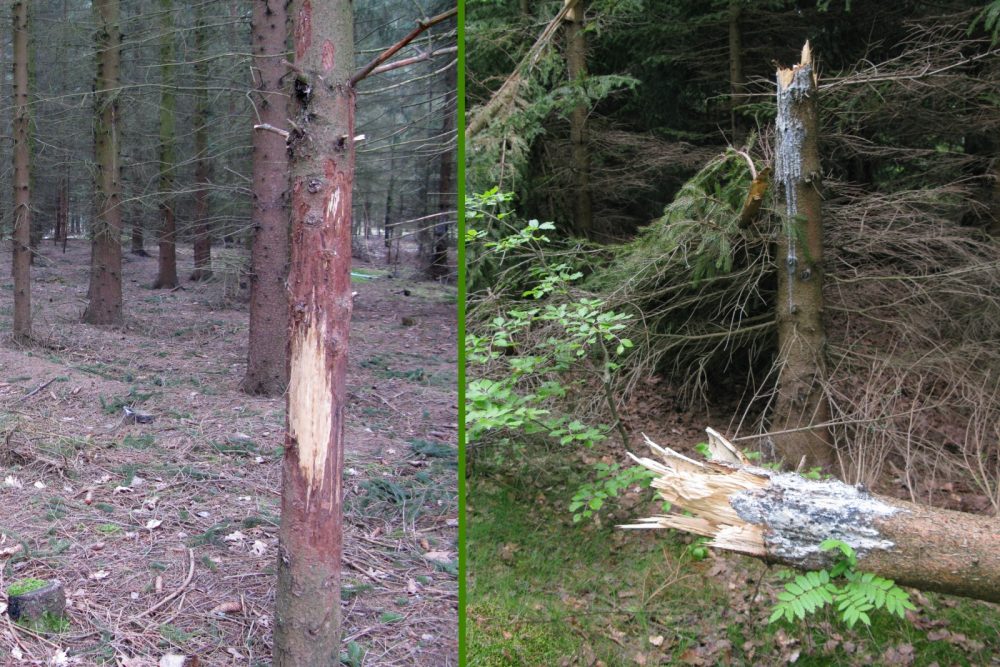Wildlife game is able to destroy totally every seventh little tree, during forest regeneration
 The ever-increasing numbers of game cause high damage to forests. Given the ongoing bark beetle calamity and due to associated increase of calamity areas, game pressure is often one of the limiting factors for subsequent forest regeneration. Without consistent protection against damaging by wildlife, the restored forest would be significantly degraded. Damages caused by wildlife game present a limiting factor for successful forest regeneration, especially in the transformation of spruce-dominated stands into species-diverse, stable and long-term economically sustainable forests.
The ever-increasing numbers of game cause high damage to forests. Given the ongoing bark beetle calamity and due to associated increase of calamity areas, game pressure is often one of the limiting factors for subsequent forest regeneration. Without consistent protection against damaging by wildlife, the restored forest would be significantly degraded. Damages caused by wildlife game present a limiting factor for successful forest regeneration, especially in the transformation of spruce-dominated stands into species-diverse, stable and long-term economically sustainable forests.
Repeated browsing of European beech, photo Jan Liška
The staff of the Institute for Forest Management (ÚHÚL) uses the National Forest Inventory (NIL) or the new Monitoring of the Status and Development of Forest Ecosystems (SSVLE) to objectively determine the degree of forest damage. Obtained outputs about forest damage are suitable even for smaller areas due to their large number.
In addition, the Hunting Act requires users of hunting areas to plan their hunting plan, inter alia, on a comparison of control and comparison areas (KSP). Forest owners over 50 ha are obliged to place at least one KSP per each 500 ha of forest started. In these KSPs, there is both the state of forest regeneration and the degree of damage to game are assessed. This KSP network was also used by ÚHÚL staff in their evaluation.
The KSP method also makes it possible to quantify the effect of damage caused by game on the biodiversity of forest tree species, the loss of trees by total destruction or losses in the height increase of tree species. An independent survey is carried out by employees of the Forest Protection Expert Group at ÚHÚL Brandýs nad Labem. They presented their results in the publication Forest Protection Newsletter (Zpravodaj ochrany lesa), Harmful Factors in the Forests of the Czech Republic (Škodliví činitelé v lesích Česka) 2021/2022 (Volume 25, 2022). Exactly obtained and statistically processed data show an astonishing extent of damage by game to small tree individuals.
The verification research was conducted on 1383 KSPs located throughout the Czech Republic, measuring 112,607 trees in fenced areas, and 94,826 trees in the free part of KSP (a total of 207,433 trees).
There was by average 13.4% less trees in the open area, if compared with the fenced part (it is assumed that 100% of trees in the fence are free of game threat). Similarly, there were, by average, 15% fewer tree individuals per 1 m2 in the open part of the KSP than in the fenced area.
 For 70% of tree species, there were more individuals in the fence than in the open area. During forest regeneration, 46% of willows, but also 34% of fir and Douglas fir, 29% of babyka maples, 21% of elms, 19% of bird cherries and 14% of ash trees used to be currently destroyed by browsing or frying. Even in case of other tree species, the destruction by browsing exceeds the difference in density by more than 10% in comparison with the fenced part of KSP.
For 70% of tree species, there were more individuals in the fence than in the open area. During forest regeneration, 46% of willows, but also 34% of fir and Douglas fir, 29% of babyka maples, 21% of elms, 19% of bird cherries and 14% of ash trees used to be currently destroyed by browsing or frying. Even in case of other tree species, the destruction by browsing exceeds the difference in density by more than 10% in comparison with the fenced part of KSP.
Browsing of silver fir (left) and of European beech (right), photo by Jan Cukor
In 63% of the detected cases, a larger number of trees were found in the fenced part of the investigated KSPs. In most localities, the forest regeneration leads to the loss of trees by their destruction by excessive damage caused by game wildlife. Surviving trees also suffer from damage and significant loss of growth.
ÚHÚL staff found a statistically significant difference between the average height of trees of all trees in the fenced part (90 cm) and in the unfenced part (65 cm). The difference is 25 cm, which means that the trees in the open area are 28% smaller than in the fenced areas.
In 95% of tree species, the average height in the fenced part of the KSP was bigger than in the open area. A statistically significant difference in the height (loss of growth) of fenced and unfenced trees was found in case of 89% of more frequently represented tree species (beech, pine, birch, oak, hornbeam, fir, Douglas fir, elm, rowan, ash, maple, linden, larch, poplar, bird cherry and willow).
The limit of 25-27% is considered a critical loss of growth rate. With a greater loss of growth of a given tree species, there are already so many damaged individuals in the stand that they begin to die due to damage by the game.
In the case of mixed forest stands, there is also interspecies competition, with less attractive species for browsing subsequently outgrowing tree species that are more attractive for browsing and often causing their death. In the surveyed KSPs, the critical growth loss threshold is reached or exceeded in 78% of the more frequently represented tree species. As the most affected tree species by the disproportionate loss of growth, i tis possible to mention Norway maple and sycamore maple – 58%, bird cherry – 53%, hornbeam – 52%, poplar – 51%, rowan – 50%, field maple – 44%, linden – 40%, birch – 39%, oak – 34 %, ash – 31%, elm – 25%, fir, Douglas fir, larch, beech – 25%.
 Strong chronic browsing by game causing the affected tree to become crooked and starting a gradual “escape”. Photo Jan Liška
Strong chronic browsing by game causing the affected tree to become crooked and starting a gradual “escape”. Photo Jan Liška
During the forest regeneration, browsing of terminal shoots would cause in the vast majority of sites to reduce tree growth. In only three monitored areas the average loss of growth for all tree species does reach a tolerable level (up to 25%), while the Pilsen region and the Bohemian-Moravian Highlands suffer from a high loss of biodiversity due to browse. For the other 12 areas, the loss of growth is above this critical limit. Thus, a disproportionate loss of growth occurs not only locally, but in most parts of the Czech Republic.
It is very visible, how significant is the height difference for individual tree species in the fencing and outside the fencing. All tree individuals are much smaller without fencing, which causes not only significant economic losses but also a reduction in forest biodiversity, as taste-sensitive species disappear from forest stands, the forest loses its stabilizing element and its resistance to other harmful factors.
In case of 67% of the more frequently represented tree species being measured, the total damage was found as bigger than 50%. This can be considered as very severe damage. The total damage was considered the presence of at least one browsing tree in the last four years of the terminal shoots, or the presence of a tree stem frying.
A total of 51.5% of the trees in the surveyed KSPs were damaged in terminal shoots during the last four years. Every year, the damage of terminal shoots reached 19.2% in average.
 The results of the KSP comparison clearly show the influence of game on tree species composition during forest regeneration, as well as the influence of game on the density and growth of individual tree species or the degree of trees damage by game.
The results of the KSP comparison clearly show the influence of game on tree species composition during forest regeneration, as well as the influence of game on the density and growth of individual tree species or the degree of trees damage by game.
Browsing of Norway spruce bark by hoofed game with following stem damages, photo Jan Liška
Also, the results indicate that game browsing in individual KSP areas has caused elimination of 13% of tree species, on average. The game wildlife completely destroys an average of 15% of the trees during forest regeneration. The damaging of the surviving trees is so strong, that it reduces the height increase by 28%, which exceeds the critical value of the loss of growth (25%), being recognized abroad.
As the most fundamental indicator of tolerable damage, it can be considered the reduction of the composition of populations of tree species in the forest, i.e. proportion of destroyed tree individuals by game wildlife (silver fir and Douglas fir – 34%, bird cherry – 19%, ash – 14%, etc.), which is more important for long-term sustainable forest management than losses in growth or scope of browsing.
Such damage intensity significantly reduces the stability and resistance of forest stands against other abiotic and biotic harmful factors, also this makes it difficult to secure forest stands within the legal deadlines, and even this makes it difficult to comply with the minimum proportion of both amelioration and stabilizing tree species. This type of damage leads to high economic losses in the growth of forest tree species and significantly increases the cost of protective measures that need to be spent against damages caused by wildlife game, above the legally required limit of these costs.
More information about damages caused by wildlife game can be found in publication Forest Protection Newsletter Harmful Factors in the Forests of the Czech Republic (Zpravodaj ochrany lesa. Škodliví činitelé v lesích Česka 2021/2022 (Svazek 25, 2022)
Authors of the paper Evaluation of forest damage by game by comparison of control and comparison areas in Czech Republic in 2013-2021 (Vyhodnocení poškození lesa zvěří pomocí porovnání kontrolních a srovnávacích ploch v ČR v letech 2013-2021): Kamil Turek, Štěpán Křístek, Jaroslav Kubišta, Jan Vrobel, Radim Strejček, Pavel Tomeček; ´Forest Management Institute (ÚHÚL) Brandýs nad Labem, e-mail: Turek.Kamil@uhul.cz
News prepared by: Ing. Jan Řezáč, e-mail: rezac@vulhm.cz
